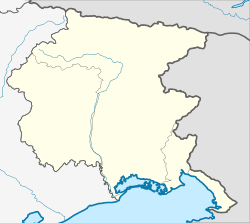Muggia | |
|---|---|
| Comune di Muggia Občina Milje | |
 Muggia in 2007 | |
| Coordinates: 45°36′N 13°46′E / 45.600°N 13.767°E | |
| Country | Italy |
| Region | Friuli-Venezia Giulia |
| Province | Trieste (TS) |
| Frazioni | Aquilinia (Žavlje), S. Barbara (Korošci), Chiampore (Čampore), Zindis, Lazzaretto-S. Bartolomeo (Lazaret - Sveti Jernej), Belpoggio (Beloglav) |
| Government | |
| • Mayor | Paolo Polidori (since 2021) (League) |
| Area | |
| • Total | 13 km2 (5 sq mi) |
| Elevation | 3 m (10 ft) |
| Population (31 May 2007)[2] | |
| • Total | 13,412 |
| • Density | 1,000/km2 (2,700/sq mi) |
| Demonym(s) | it. Muggesani sl. Miljčani |
| Time zone | UTC+1 (CET) |
| • Summer (DST) | UTC+2 (CEST) |
| Postal code | 34015 |
| Dialing code | 040 |
| Patron saint | Saints John and Paul |
| Saint day | 26 June |
| Website | Official website |
Muggia (Triestine: Muja; Friulian: Mugle; Slovene: Milje) is an Italian town and comune (municipality) in south-eastern regional decentralization entity of Trieste, in the region of Friuli-Venezia Giulia on the border with Slovenia. Lying on the eastern flank of the Gulf of Trieste in the northern Adriatic Sea, Muggia is the only Italian port town in Istria. The town's architecture is marked by its Venetian and Austrian history, and its harbour hosts a modern 500-berth marina for yachts (Porto San Rocco).
Muggia lies in northern Istria. Its territory, limited on the sea-side by a shoreline of more than 7 kilometres (4 mi) featuring a coastal road and on the border side by a hill system, Monti di Muggia, including Mt. Castellier, Mt. S. Michele, Mt. Zuc and Monte d'Oro, that dominate over a vast landscape of Triestinian and Istrian coast, is characterized by a rich sub-continental vegetation of both Karstic and Istrian type.
It has a border crossing, known as San Bartolomeo, with Slovenia and the extreme east of the comune at Lazzaretto. The Slovenian border crossing is called Lazaret in the Municipality of Koper.
- ^ "Superficie di Comuni Province e Regioni italiane al 9 ottobre 2011". Italian National Institute of Statistics. Retrieved 16 March 2019.
- ^ All demographics and other statistics: Italian statistical institute Istat.




